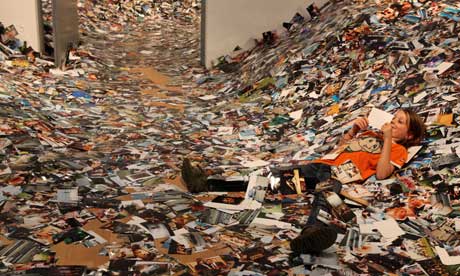Digital photography's bright new world
With professional-standard cameraphones, technology that can tell whether everyone's smiling and the vast array of image-manipulation apps, it's hard to take a dud photo these days.

Every photograph uploaded to Flickr in one day, printed and exhibited in Amsterdam: “24 hr photos” , an installation by Erik Kessels. Photograph: © Gijs van den Berg/Courtesy of FOAM Magazine
The strange thing about photography is that although it's been revolutionised by digital technology, at heart it's the same medium that entranced Louis Daguerre, Eugène Atget and André Kertész, to name just three of its early masters. And although it's become much easier to take photographs that are technically flawless (in terms of exposure and focus), it's just as difficult to capture aesthetically satisfying images as it was in the age of film and chemicals. It turns out that technology is a necessary, but not a sufficient, condition for creating art.
Still, the technology is pretty impressive. Almost every digital camera on the consumer market today is a marvel of automation, with auto-focus that generally works, metering systems that accurately assess light (at least on evenly illuminated scenes) and do a passable job of reducing the red-eye effect produced by direct flash. The newer consumer cameras go much further than this, offering face detection (so that you don't wind up taking photographs of people's shoes) and now even (so help me God) smile detection. So while it is still possible to take terrible pictures with these devices, you have to work pretty hard to achieve a convincing display of incompetence.
The result is a world where an unimaginable number of photographs are taken every day. Photo-hosting services such as Picasa and Flickr, and social networking sites such as Facebook, now host upwards of 100 billion images between them. The scale of this abundance is really hard to grasp, but recently an Amsterdam gallery had a shot at it, by printing off a copy of every photograph uploaded to Flickr in a 24-hour period and then shovelling the resulting avalanche into a succession of rooms, all of which were waist-high in photographs. And Flickr is small beer compared with Facebook.
The pace of change in technology has also been dramatic and not just in terms of the "megapixel wars" over the number of pixels that could be fitted on to a sensor. As sensors improved, the industry spotted a demand for more sophisticated cameras and so the digital single lens reflex (DSLR) was born, complete with prismatic viewfinder, a mirror that flipped up when you pressed the shutter, interchangeable lenses and all the other paraphernalia of "serious" photography.
This worked for a while, until people discovered that packing a DSLR and a couple of lenses meant that you could only bring a toothbrush before you'd exceeded Ryanair's cabin baggage allowance. So the quest was on for something that functioned like a DSLR but didn't have all that clunky mirror stuff. The result was a new line of cameras with the catchy (not to say incomprehensible) tag of "micro four thirds" such as the Olympus PEN series (see below). These will probably be the must-have devices this Christmas.
In recent years, the whole concept of what constitutes a camera has been up for grabs. As an inveterate photographer, I used to carry a Canon IXUS with me everywhere, sitting snugly in a leather case on my belt. But then I bought an iPhone4, the first mobile phone I'd owned that had a decent camera. You can guess the rest of the story: more often than not, the IXUS now sits at home on a shelf.
The reason is obvious. It's the old photographer's adage that the best camera is always the one you happen to have with you. Since most of us carry mobile phones, it was inevitable that once their onboard cameras became powerful enough to produce reasonable pictures then they would become the default photographic device. That's one reason why the iPhone is now the most popular camera among Flickr users.
The other reason for the popularity of cameraphones is that smartphones are actually quite powerful computers, which means they can run software that does quite sophisticated image-processing, something beyond the capacity of the feeble processors that power conventional digital cameras. So the market for photo apps that can do stuff such as high dynamic range (HDR) photography, or produce all kinds of weird retro effects, has exploded (see panel below).
This, in turn, is a harbinger of the next big thing, what geeks call computational photography – that is to say image-making that owes as much to computing as it does to optics. The best-known example is light field photography, a technology that captures all the light in a particular subject and produces not a flat, two-dimensional image but a virtual cube out of which 2D images can be sliced by taking cross-sections through it. Once upon a time, this required a roomful of computers, but the room has now been shrunk to the size of a handheld consumer device. The Lytro light field camera hits the streets early in 2012. It's a long way from the Kodak Box Brownie that made photography a consumer pastime, but, hey! that's progress for you.
http://www.guardian.co.uk/technology/2011/dec/04/digital-photography-latest-camera-technology
This article expresses the point that photos are now taken of anything anywhere without a thought because of the ability to do so which wasn't the case with analog as it cost money and was limited to the amount of film in the camera. This could be something that I promote in order to exhibit analog photography in a positive light and restore its technology.


No comments:
Post a Comment